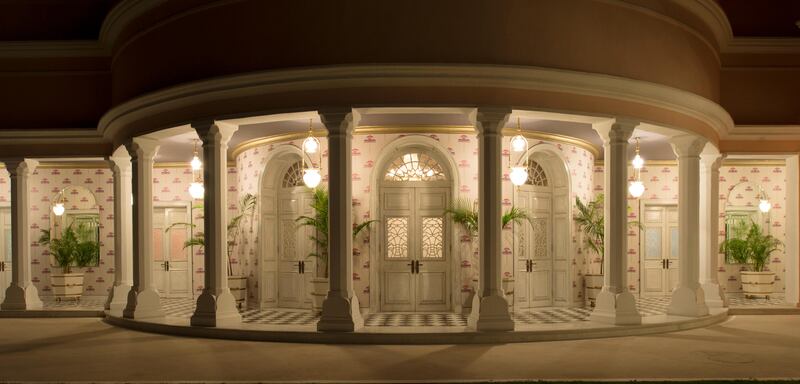How do you refurbish a palace fit for a king, creating an integrated yet opulent decor that expresses the essence of Indian royal culture and heritage, while also ensuring it will function as a contemporary boutique hotel?
When Jaipur's royal family presented the design brief for the Suján Rajmahal Palace to interior designer Adil Ahmad, a creative director at Good Earth, one of India's leading interior design and homestyling companies, his team immersed itself in the palace archives, reviewed the royal collections of antiques, rugs, frescoes, tableware and textiles at the City Palace, and travelled to Amer Fort in Rajasthan, as well as other historic sites.
The resulting design scheme is an interpretation of Indian culture, as well as a design dictionary of Jaipur, distilled into a bespoke collection of wallpapers and soft furnishings.
From 1958 to 1970, the Rajmahal Palace was the private residence of the last ruling Rajput king of Jaipur state, His Highness Maharaja Sawai Man Singh II, along with the Maharani Gayatri Devi, who was once included by Vogue in a list of the 10 most beautiful women in the world. The couple existed in a glamorous era of lavish entertainment, hosting international polo-playing kings and princes, as well as prominent figures such as Queen Elizabeth II, Earl Mountbatten and Jacqueline Kennedy. The property was also used as a British Residency, but was returned to Jaipur's royal family after India gained independence.
While no longer a royal residence, the palace is still owned by the royal family, and Maharaja Sawai Padmanabh Singh of Jaipur still hosts royal events here. The palace is now part of the Indian Heritage Hotels Association, which is dedicated to preserving historic properties and, in recognition of the uniqueness of its collection of hotels, does not use the traditional star-based system to rate them.
Akshay Chawla, resident manager of Suján Rajmahal Palace, took me on a tour of the property's 15 individually themed suites and apartments. Each living space has been given a very specific identity through the use of bespoke wallpapers and soft furnishings. "We couldn't change the layout of the building, or break walls during the refurbishment – what we could do is work with interiors and furnishings, which is what we did here," he explains. "The palace has really come up in stages. In 1729, when the foundations were laid, it was a pleasure garden with a palace for the queen at that time, and there are four chhatris [elevated domed and columned pavilions] at each corner, which mark the original boundaries of the site."
In places, the hotel has an art deco feel, reflecting architectural features that were added later in its history, such as mint-green and pink colour schemes. Inspiration for the restaurant, 51 Shades of Pink, was drawn from a photograph, which subsequently became a Vogue cover, taken within a courtyard at the City Palace in Jaipur in the 1950s by British fashion photographer Norman Parkinson. The image features countless shades of pink, from the model's dress and guard's uniform to an elephant's blanket and the palace walls. Of course, Jaipur itself has long been identified as the Pink City of India.
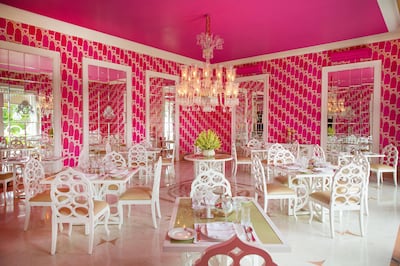
In the hotel’s Durbar Hall, references for the decor were drawn from Mughal motifs on an antique rug. The tree-and-flower pattern is projected in bold new colours across the room’s ceiling and walls.
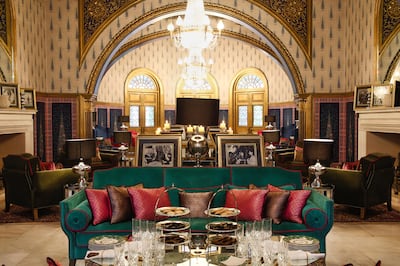
In the Vestibule, meanwhile, sits a marble piano, said to have been gifted by Queen Elizabeth II during her 1961 visit to India. The wallcovering in that hallway features an interpretation of the vast silver urns kept at the City Palace, which were commissioned by Maharaja Madho Singh II for a visit to London in 1902, so that he could carry with him sufficient quantities of "holy" water drawn from The Ganges river on his long journey.
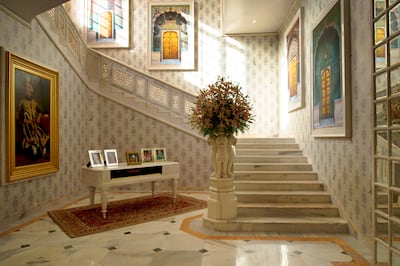
Chawla reflects on how tiny details lifted from the palace’s history have been built into the design, so that each room evokes a very different feel and mood, depending on colour and aspect. “I was told that carnations were a favourite flower of Jackie Kennedy, and these now feature in multiple incarnations in the wallpaper of the rooms that she used during her stay in India – now renamed the Kennedy Suite.”
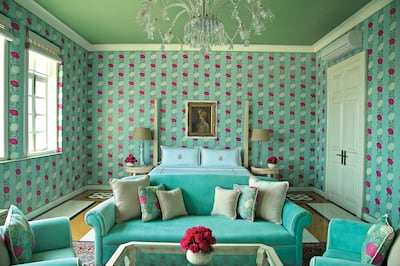
Pavitra Rajaram, who is head of design at Good Earth and one of the company's founding members, says the team was briefed to be "Indian, authentic and bold with pattern and colour". The idea, says Rajaram, was "to create a museum of memories".
The Suján Rajmahal Palace project was Good Earth's first venture into wallcoverings and, upon completion of the project, the company felt there was an opportunity to take its approach to a wider audience. "We wanted to make wallpaper that was commercially viable, yet it still had to be produced in a most bespoke manner, to the same level of quality and attention to detail as we had done for the palace," Rajaram tells us.
A collaboration with Asian Paints of India resulted and, keen to retain a handmade approach to wallpaper and to celebrate craftsmanship, they called on the production capabilities of a family-owned company in England, which still maintains the process of hand-cutting rollers and printing on papers, in contrast to most other companies, where production is now entirely digitised. "They are probably the last company in the world that still does a hand process for wallpaper production," observes Rajaram.
The wallpaper designs of the palace are exclusive to that location and have not been reproduced. However, the project provided a catalyst for Good Earth's Silk Route collection, which it launched last year. It is a fitting homage to a project that artfully combined the contemporary and the traditional, and created a new reference point for opulent Rajasthani design.
________________
Reading more:
Design dilemma: Tips for fantastic lighting
[ When fashion and interiors collide ]
[ In memory of a master: 5 homes by Guggenheim architect Frank Lloyd Wright ]
________________
